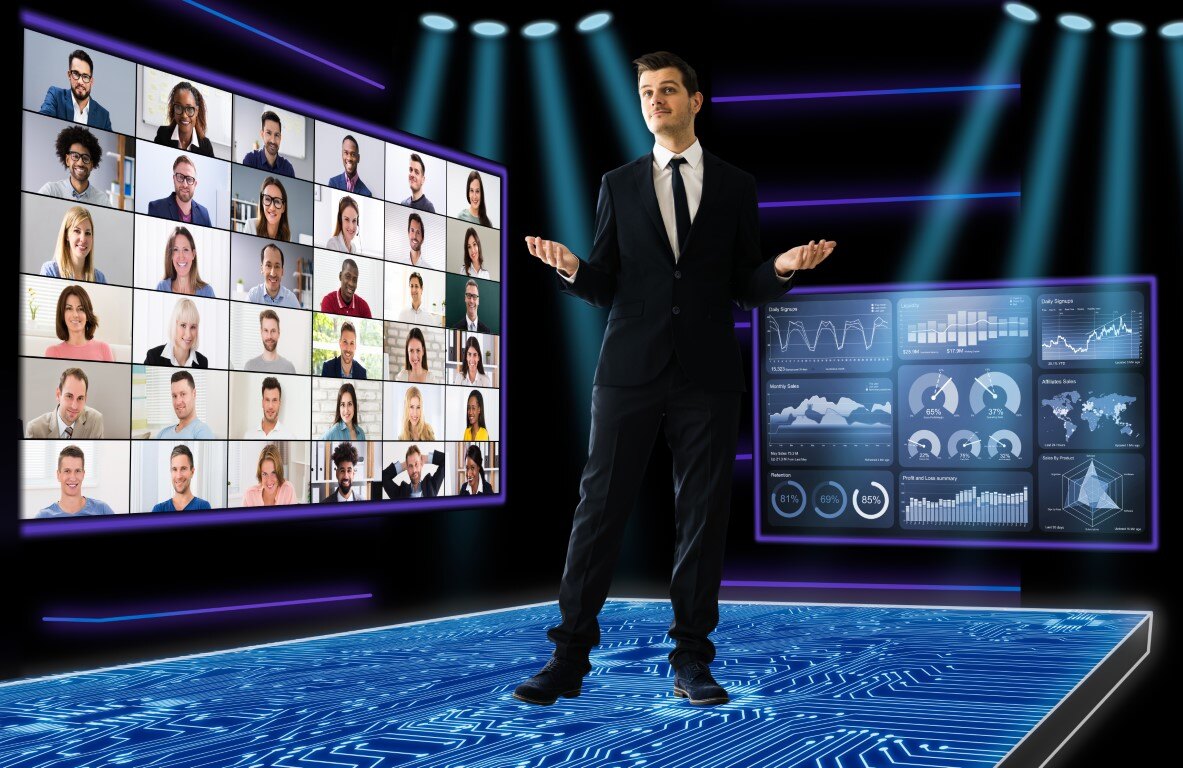Artificial intelligence at trade shows: Opportunities for your company
AI at trade shows: Innovative concepts for modern trade show appearances The trade show world is facing an exciting change: Artificial intelligence...

Virtual events have established themselves as a common form of event. They connect people all over the world and expand a company's opportunities to present its products and ideology. It is impossible to imagine the business world without them. But what will the near future of virtual events look like? At the moment, there are some clear trends that I will give you a brief overview of below.
Anyone taking part in a virtual event organized by a popular company may notice that there is more on offer than just the programme or on-demand content. Among other things, you will find opportunities to interact with other participants or upload your own content to a social wall. Visitor expectations are rising in line with the advancement of technology in this area. The design of virtual events therefore requires creative ideas and possibly additional investment in order to meet these expectations. After all, additional interactions outside of the main program are what attracts participants and keeps them on the platform.
One popular solution for meeting participants' expectations is to gamify the platform. This means that content from the video game industry is used at virtual events. For example, this could be an interactive corporate metaverse in which you can move around with a personalized avatar. Mini-games or quizzes in corporate branding, with high scores and rewards, also invite playful interaction with the event and the organizer. AR and VR content could also be an interesting option, for example allowing the company's products to be displayed in reality using a smartphone.
Good interaction opportunities at events strengthen the connection between participants and the brand and the company and encourage them to engage with them in depth. They are an essential part of a virtual event.

Just as important as interactions at a virtual event is the personalization of event content so that participants feel personally addressed. This also helps to strengthen the participants' connection to the company. Personalization is possible and easy to implement in many areas of a virtual event. Interests and preferences can be queried when registering for the event and personalized marketing emails and advertising can be sent based on this information. In addition, visitors can be forwarded directly to preferred websites and content during the event.
The event experience can also be personalized. If specific people are invited before the event, they can be asked to select specific topics or questions for the event on which presentations are to be given. After all, the event is being organized for the participants. It is therefore important to answer as many of their questions as possible or to delve deeper into topics with them.
If the best and most interesting contributions from users are then mentioned in videos, podcasts or blog posts after the event, the personalized event experience is perfect.
In order to tailor events to the needs of customers and generate more potential buyers, they are increasingly being aligned with the buyer journey. Events can be tailored to each stage of the buyer journey, making them more effective. New customers are more likely to be attracted by a presentation of the company and its products or a virtual trade fair, while for existing customers there are presentations or webinars on topics that go into more detail about the functions of the products and more complex issues. If the events are organized regularly, the likelihood that participants will automatically be taken forward in their buyer journey also increases.

In addition to adapting to the buyer journey, events are becoming increasingly topic-specific. A few years ago, event organizers were increasingly focusing on large events that appealed to as many people as possible and covered a wide range of topics. At the moment, however, the trend is towards events that take place regularly throughout the year and are limited to one topic. These small, recurring events, such as recurring training events, have the advantage that they are based on proven templates. They often have a specific design, a fixed schedule and predefined content. This reduces the cost of creating the events and creates a positive economy of scale. In event series, successes and changes in the company or products can be explained and illustrated in detail. Participants also benefit as they can plan their free time around the event calendar, which is announced well in advance.
Take a look at our solution for recurring virtual events here.
As I described above, the expectations of participants increase with the further development of technology, which is why the evaluation of user behavior is important in order to adapt virtual events to trends. A few trends in the needs of users stand out. I will present these below.
Climate friendliness is an issue in many areas of life and is also increasingly being taken into account at events. Here, a virtual event has an advantage over physical events, as, among other things, no fuel is used for the journey and no event location or catering is required. The topic of climate protection is increasingly being incorporated into presentations, content and the design of the 3D world (where available) of virtual events. Presentations on the environmental impact of the company's own products or on the company's efforts to produce in a climate-friendly way attract many people who attach importance to climate protection.
When personal data is requested everywhere on the Internet, the importance of Internet security grows. This is also something that organizers of virtual events should think about. Of course, it is easy if the implementation is placed in the hands of an external service that can guarantee a high level of data protection in addition to the smooth implementation of the event. For example, if two-factor identification or VPN is supported to prevent unauthorized access, participants will feel more secure.
With the development of new technologies, the expectations of people with physical disabilities can also be met. Every event organizer should consider implementing technologies to increase accessibility. It not only expands the range of potential buyers, but also reflects positively on the company.
Barriers can also be broken down in other areas. For example, the development of live translation is also progressing. Another important technology if you want to attract an international clientele.

The last trend I'm going to talk about in this article is hybrid events. Since the coronavirus pandemic, event organizers have recognized the benefits of combining virtual and physical events and hybrid events have enjoyed great popularity ever since. The number of hybrid events is even expected to increase in the near future. So it doesn't hurt to seriously consider whether it makes sense to supplement a physical event with a virtual counterpart.
We know that virtual events will continue to play an important role in the future. They are easily accessible, attract people worldwide and are more cost-effective than physical events. But they also require careful planning and strategy to attract and engage prospects. Especially in the face of increasing competition, the content and format of events need to be carefully planned so as not to lose participants before and during the event. Fortunately, there are more and more providers offering interactive and interesting event platforms that are constantly being developed further. It is exciting to see what other possibilities will emerge in the field of virtual events in the near future.

AI at trade shows: Innovative concepts for modern trade show appearances The trade show world is facing an exciting change: Artificial intelligence...

Presenting a product at a trade fair is often a challenge, especially if the product is difficult to transport. In such cases, companies often rely...

Trade fair presentations have changed fundamentally in recent years. In the past, pure product presentations dominated, with exhibitors standing...